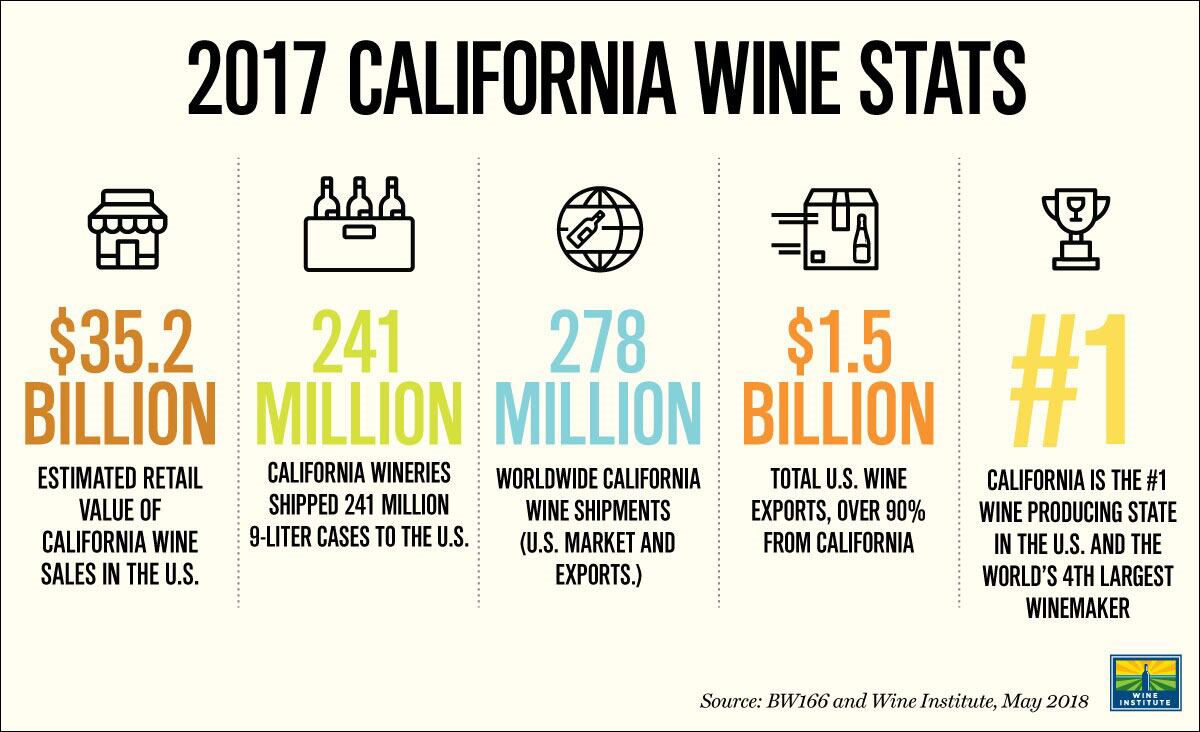One consistent trend is premiumization, according to California wine industry body Wine Institute, which says that California’s wines are well-positioned for growth in this category.
And e-commerce is helping expand consumer access to wine, with wineries working on several digital platforms to sell their products.
Grown in premium wines
California is the world’s fourth largest wine producer, and is the largest wine producer in the US, accounting for 60% share of the US market.
California wine shipments in the US reached an estimated retail value of $35.2bn in 2017, up 3% from the year before. The state shipped 241 million nine-liter cases in the U.S. in 2017, up 1%.
Total wine sales to all markets, including shipments to the US and exports worldwide, were 278 million cases in 2017.
Last year the growth came mainly from premium wines priced over $10.

US wine sales
Rosé continues to be a ‘phenomenal growth story’, with sales volume up 60% in 2017.
The top-selling varietals by volume in US off-premise sales, according to Nielsen figures, are Chardonnay, Cabernet Sauvignon, Red Blends, Pinot Grigio/Gris, Pinot Noir, Sauvignon Blanc, Merlot, Moscato/Muscat, Rosé and White Zinfandel/Blush.
Total shipments of sparkling wine and champagne reached 26.3m cases in 2017, up 8%, accounting for a 7% share of the US wine market.
“Consumers in the US and worldwide continue to trade up to higher-priced premium wines,” said Robert P. (Bobby) Koch, Wine Institute President and CEO.
“The quality, selection and commitment to sustainability make California wines well-positioned for growth.”
Changing demographics
Demographic trends have played a significant role in the increase in wine sales, according to the Gomberg-Fredrikson Report.
While per capita consumption has changed little over the last decade, wine sales have grown in line with the legal drinking age population, which increased roughly 10% over the same time period.
Meanwhile, wineries have increased their focus on tasting room and direct-to-consumer sales, which accounted for nearly $2.7bn in retail value and 5.8 million cases in 2017.
Wineries also find opportunities in independent, local restaurants: with wine menus listing limited production wines to appeal to consumers shifting their spending to these smaller eating establishments.
Changing retail landscape
Wine selling locations in the US are up 20% compared to a decade ago, with 565,000 off and on premise locations, according to Nielsen. These are increasingly divers: from natural or gourmet grocery stores through to no frills and value-based formats; to theaters, premium bars and fast/casual on-premise outlets.
Add into that the broad range of wine consumers and wine marketers need to think carefully about how they present products, says Danny Brager, senior vice president of Nielsen’s beverage alcohol practice area.
“There is a diverse range of consumers, from Millennials who have less disposable income than a generation ago to Baby Boomers who are retiring and likely slowing their wine consumption as an increasing number of Americans are entering their golden years.
“Marketers need to find the right balance in attracting these diverse sets of consumers.
“And e-commerce is increasingly having an impact on expanding consumer access to wine, and wineries are working on several digital platforms where wine is being sold.”
US wine exports
US wine exports reached $1.53bn in winery revenues in 2017, while volumes reached 380 million liters.
The EU is the top market for wine exports, accounting for $553m. This is followed by Canada ($444m), Hong Kong ($119m), Japan ($94m) and China ($79m).
California wines make up more than 90% of US wine exports.
